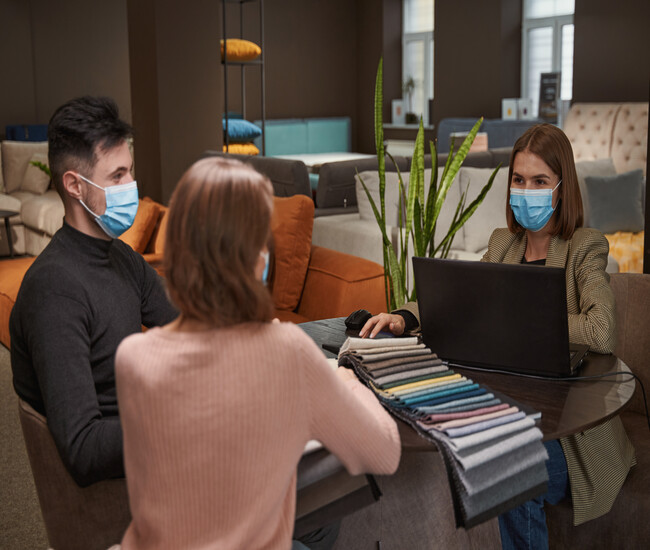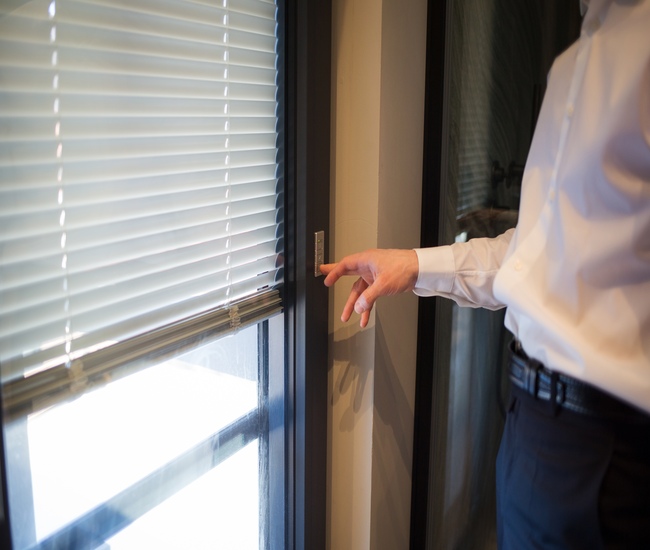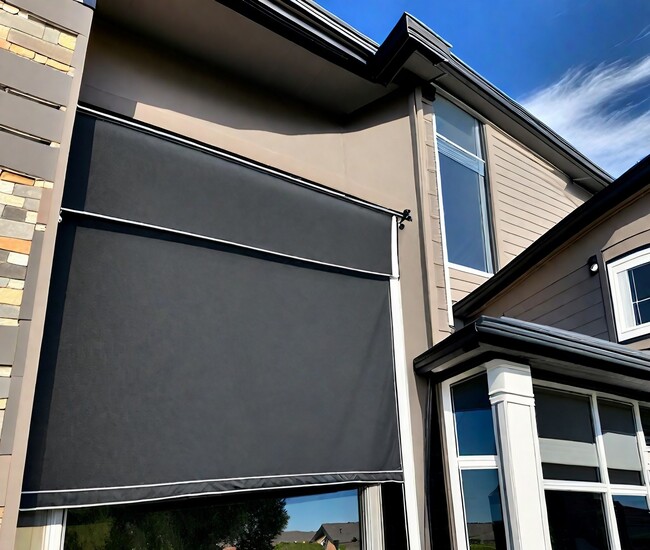Yes! Solar shades are the perfect way to cut down on glare and block UV rays and heat, without losing your view outside. Solar window treatments come with various opacity levels or openness percentages, such as 1%, 3%, 5%, 7%, 10%, and 14%, that address the amount of UV light that the blind lets into your room. Similarly, different opacities offer different levels of glare control in your study room, media room, classroom, or home office.
Lower opacities (1% to 5%) will keep more safe UV rays out of your home and better cut down on glare, but they will make your view fuzzier. A 1% opacity solar shade will let only 1% of all UV rays into your room.
If you are looking for a shortcut to effectively reduce glare and ultraviolet (UV) rays with your solar roller shades, just read on. Glare reduction and UV protection can provide you with a safe, comfortable, and healthy environment.
What Are Solar Shades?

Solar shades, also referred to as sunshades, are roller blinds crafted with a specially designed fabric that’s woven just tight enough to protect against ultraviolet radiation and harsh glare. They can also improve the energy efficiency of your home. These shades offer a great way to add the benefits of a versatile window treatment.
If perfectly installed with the right openness level, sun shades can significantly reduce the risk of skin cancer. There are some secondary benefits of such window treatments, such as temperature regulation and privacy.
Key Benefits of Solar Shades
- Block UV rays and heat
- Reduce glare
- Enhance ambiance of your space
- Improve your health
- Increase comfort
- Increase energy efficiency of your home
- Add to your home value
How Do Solar Shades Protect from Harmful UV Rays and Glare?
The special fabrics of solar roller shades absorb the major portion of sun rays and reduce glare and heat, making your living space or workspace more comfortable. While mitigating the impact of sunlight, they preserve visibility and maintain a view of the outdoors.
Steps to Effectively Reduce Glare & Block UV Rays with Solar Shades
Reducing glare and UV rays with solar shades is a practical and cost-effective way to create a more comfortable, healthier, and more visually attractive environment in your home office, home theater, living room, or other room. Here’s a quick step-by-step guide on how to maximize glare reduction and UV control using sunshades:
Assess the Glare Source
Identify the windows where the glare is most prominent and causing trouble when you work on screens. Observe the intensity and direction of the sunlight during the times when glare is a problem.
Choose the Right Opacity for Your Solar Blinds Fabric

Opacity for solar blind fabrics with lower openness percentages, like 1%, 3%, 5%, or tighter weaves. These fabrics can block out a significant amount of sunlight and reduce glare effectively. Look for fabrics with Visible Light Transmission (VLT) ratings and high Solar Heat Gain Coefficient (SHGC).
Accurately Measure Windows to Prevent UV Leakage
Accurate measurements of window frames are crucial to ensure that the heat-blocking blinds give a proper fit. Before installing, measure the width (w) and height (h) of the windows where you plan to install the sun shades. Follow the manufacturer’s instructions for precise measurements.
Select the Appropriate Mounting Style
Decide whether you want to install your solar window treatments as an inside mount or an outside mount. The choice for mounting style will depend on your window type and personal preferences for curb appeal and functionality. For example, inside mounts provide a sleeker appearance, while outside mount blinds can block more light.
Properly Install Your Solar Shades
Follow the manufacturer’s instructions for installing your shades on windows. Ensure that the mounting brackets are securely attached and the blinds are properly aligned.
Position the Solar Shades
Adjust the position of the solar roller blinds to minimize light gaps and glare effectively. Fully cover the portion of the window opening where the glare originates from. Try different positions until you get the desired reduction in glare.
Utilize Partial Coverage
If the glare and UV rays are concentrated in specific areas, consider using solar shades on those specific windows. This will allow you to reduce glare and ultraviolet radiation where it’s most needed while still allowing natural light to sail into other areas to create a soft glow.
Consider Layered/Dual Shades
Some solar window coverings come with dual or double-layered fabrics for better light control and glare reduction. Adjust the position of the dual blinds to find the perfect balance between reducing glare, blocking harsh light, and maintaining the desired levels of sunlight.
Angle Your Solar Shades
Depending on the angle of the sunlight, you can tilt the solar blinds slightly upward or downward to further minimize glare and UV rays.
Consider Time-Sensitive Automation

If available, explore the option of motorized or smart solar shades with light sensors or timers. These smart shades can automatically open, close, or adjust throughout the day based on the intensity of sunlight, providing continuous glare reduction and UV protection without manual intervention. A cordless or motorized lift option also ensures the safety of young children and pets in your home.
Regular Care & Maintenance
Keep your solar shades clean and free from dust, dirt, or debris. Regularly wipe down the shades with a soft cloth or use a vacuum cleaner with a brush attachment to prevent any buildup of debris that may affect their effectiveness in reducing glare and UV rays.
By following the above step-by-step guide and using the appropriate solar shades, you can maximize glare reduction and UV control to create a more comfortable and visually appealing environment in your home, office, or other building.
Measuring Instructions for Solar Shades

Here is our DIY step-by-step guide on how to measure windows for solar shades to get started.
- Measure Width: Measure the width of the windows at top, middle, and bottom. Record the narrowest value.
- Measure Height: Measure the height of the top of the window or other space from the top to bottom in the left, middle, and right. Record the shortest measurement. For example, if the measurements are 61”, 61 ¾”, and 61 ¾”, order blinds measuring 61 inches in length.
- Deduction: Do not make any deductions. We’ll do it for you.
Steps to Install Solar Shades for Maximum Sun Protection

For a professional, inch-by-inch, edge-to-edge fit, follow DIY step-by-step guide on how to install solar window treatments.
- Step 1: Drill holes (using a ⅜-inch drill bit)
- Step 2: Set up the brackets with screws and a screwdriver.
- Step 3: Hang your window covers.
FAQs
What blinds are best for blocking UV rays?

Solar blinds with 1% openness percentage are best for blocking UV rays. Openness or opacity refers to how tightly the fabric is woven. A solar blind with 1% openness will block out 99% the harsh UV rays, while only allowing 1% of them to enter into your room. For 100% UV protection, you can go with blackout solar shades.
Can you see through solar roller shades?
Yes, you can see through solar roller shades to have a view of the outdoors, but passers-by can’t see in during the day. The effect is reversed at night. Solar roller shades have an open weave fabric that allows light and air to pass through. So, they’re not a good option if you are looking for two-way privacy.
Further Assistance
Still unsure how to reduce glare and block UV rays using solar shades? Get in touch for further help now! Use 24/7 live chat or give us a call at (800) 863-6109 to contact our experts for custom solutions.
